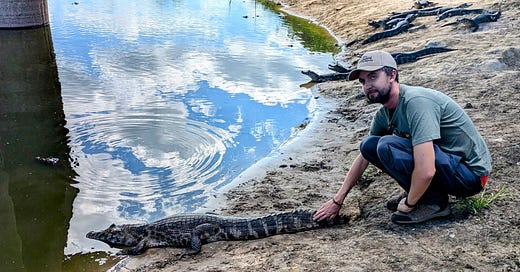Caiman bothering and other ways to make friends
"Mid-life" woman fails to see world wonders, jaguars. She's great at fishing though.
Our exit strategy out of Paraguay was a little convoluted. At the Mbaracayú Lodge, where we’d been enjoying a few days of gentle walks in the forest with the birds and monkeys, we were only a few miles from the Brazilian border. But with no car and a great big nature reserve between it and us, we needed to head south once again towards Ciudad del Este, where the forecast for onward bus connectivity was fair.
As is so frequently the case in Paraguay, our journey wasn’t far as the crow flies, and probably wouldn’t have taken long by car, but by bus it required a bit more luck and optimism. I’ve talked about this before, but in Paraguay it was often desperately unclear what the correct bus times and connections were until we were at the bus terminal, or even on the bus already – and even then it was up to the gods as to how long the journey will take. Which was particularly unhelpful on days like this where we needed to get several connections.
Getting to Mbaracayu from Encarnacion had worked out fine once we’d resigned ourselves to getting the earliest bus out, at 5.30am. But coming back the other way we decided to pay over the odds for a car to take us from the reserve to the connecting town of Curuguaty, a place of large, directionless discount stores and people sat outside them who liked to point and stare at the funny gringos. From there it was a four-hour bus down to Ciudad del Este (CdE), a city described to me by a cynical Paraguayan as “the real Paraguay – or at least where the country is heading”. I can confirm now having seen the place that this statement is depressing if true.
CdE is the third corner of the Tres Fronteras triangle formed by Brazil, Paraguay and Argentina: it sits just the other side of the Iguazú Falls, which we saw from both Brazil and Argentina back in November 2023. In a cruel twist of fate (or border diplomacy), Paraguay doesn’t share access to the falls; it actually used to have an even bigger set of waterfalls than Iguazú, but sacrificed them in favour of building the Itaipú hydroelectric dam in the 1970s.
To be fair to Paraguay, the dam is now listed as one of the seven modern wonders of the world. It is the second most productive dam in the world, provides 90 per cent of of Paraguay’s electricity (which feels risky), and 10 per cent of Brazil’s, and it is apparently very impressive to see. Unfortunately, when Dave and I set out to see the dam it was a Sunday, and we were thwarted by a lack of buses and realised all too late that the dam closes early for visitors on Sundays at any rate, so we’ll just have to save that modern wonder for the next trip.
I swear it’s not just my bitterness talking, but I’m highly suspicious of just what counts as a “world wonder” – the internet seems to have quite a few different lists going on and some of the sources tasked with comprising them are dubious (USA Today newspaper??) – but I can tell you it’s at least the second time Dave and I have failed together at seeing an official wonder. On holiday in Bodrum, Turkey, back in 2017, we were a couple of kilometres down the road from the Mausoleum at Halicarnassus, and every day we said to each other that we should probably go and see it… tomorrow. But the truth is, those sun-loungers were just too comfortable and the beachside bar too accomodating for us be arsed.
Looking at photos of the Mausoleum online now it does just look like a pile of rubble, so maybe it’s no big loss. But this exercise has opened up a whole can of worms. I’m looking at the seven wonders of the world, “nature version” now, a separate list, and I can tell you I’ve been to Vietnam and not seen Ha Long Bay; I’ve been to Palawan in the Philippines and not seen the Puerto Princesa Underground River (what is that?!) or indeed Komodo Island when I was in Indonesia. Not that I can remember, anyway. But it’s always good to have an excuse to go back.
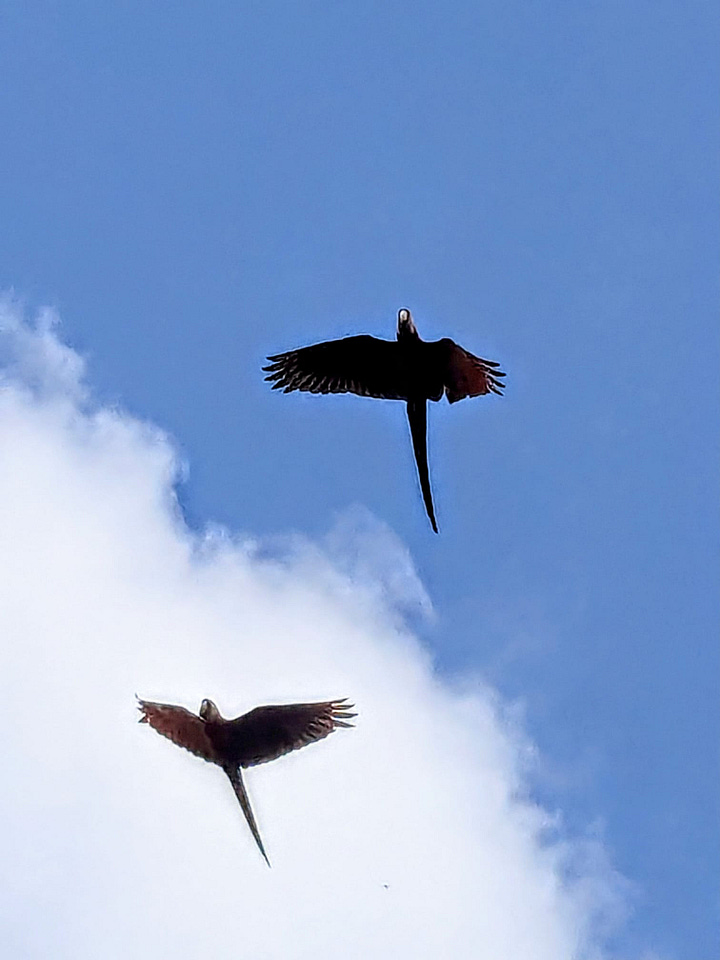
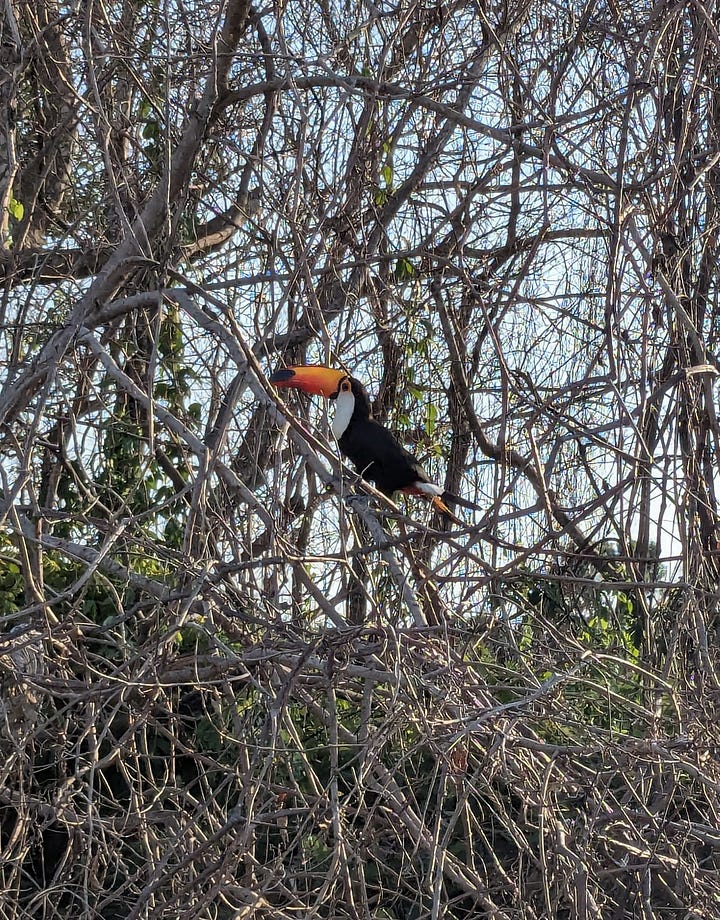
Our failure to see the dam did at least leave us with plenty of time to explore CdE city itself, though once again this didn’t appear to be an option on a Sunday, when the country’s busiest city – famous for the thousands of duty-free shops flocked to by Paraguayans and Brazilians every other day of the week – appeared to be completely closed. We walked a few miles in the blazing heat before I gave in to a roadside burger and a beer at a trucker’s bar outside a closed-up mall; we took a short walk around the pleasant enough lake, then found ourselves in an Arabic restaurant for dinner (delicious but halal, so alcohol-free). To top things off, the Airbnb we’d chosen for its promising ratio of price to kitchen and living space turned out to be a very bleak little metal box that made us both feel too depressed to spend much time in.
If nothing else, the bleakness of Paraguay’s eastern-most city geared us up to feel more than ready for our departure the next morning. And it was a satisfyingly straightforward crossing: an Uber to the border, a 20-second walk through immigration, and a short hike across the International Friendship Bridge and over the Paraná river to Brazil – where immediately life felt five-times more commercial, organised and expensive, which at least meant a more navigable bus timetable.
We took a long bus to Londrina, Dave’s new home for the fortnight, and a day later I set off before dawn to make my steady way east once again to São Paulo, the airport, Lisbon, and finally, London.
It’s amazing how immediate the difference between travelling as a pair and travelling alone can be felt. As a solo traveller people talk to me a lot more, for better or for worse. On the subway platform in São Paulo, I ended up chatting to a very nice student called Gabriella; she was studying music, spoke great English but had never left her own city. She shared her internet hotspot with me and we showed each other photos of our family dogs.
Earlier that day, climbing up to the top deck of my bus from Londrina, I found a pair of gringo legs on my seat – not a regular occurance in these parts, and funny how, once again, the only two white people on the bus were positioned next to each other. I tapped the legs awake and discovered that they belonged to Kane, a 25-year-old New Zealander who really loved to chat.
Kane left school at 13 after getting into trouble too many times for selling drugs. He won’t read this, because he doesn’t read well, but he is, apparently, very wealthy after setting up and selling off his own marketing business by his early twenties. And I believe him for a few reasons: one because he told me in great detail all about his entrepreneurialism, the many little businesses he’s started, the cold calling and door knocking and general wise-guy pluckiness required to succeed at that. He was a gifted talker, but then he believes in himself a huge amount. And he had no reason to bullshit me, because once he learned how very old I was, he said he found it “refreshing” to talk to, and I quote, “a woman in mid-life” (I am 35). Oh, and Kane likes girls (his own age) – A Lot.
It’s amazing what people are willing to share with strangers. I’m a nosy journalist by trade, so of course I love that. I learned a lot about Kane, a lot of which isn’t repeatable here, but for part of the time I listened to the apparently unsolvable dilemma of how the young woman he loves back home probably wants to get serious. She’s perfect (perfect!) but he’s too young to settle down, but then again he’s afraid to leave it too late – because it would be terrible to be left single and without any decent women left to marry once you hit 30, how embarrassing.
I introduced him to the concepts of toxic masculinity, feminism (ok, he had heard of that one but wasn’t sure about it) and explained why it’s ok to be unmarried at 35 and that he needn’t feel sorry for me. I think we shared some lovely moments of deep learning. But mostly I listened to Kane talk about Kane, which was entertaining but oh wow, endless, for the duration of our 10-hour bus journey.
I like to think I redressed this balance of gendered emotional labour somewhat by somehow bullshitting my way into the Amex VIP Lounge at São Paulo airport – possibly because the guy on the desk made a mistake, possibly because he pitied me or liked me or both, but maybe after 10 hours of The Kane Experience I was carrying with me a tiny bit of that white young male bravado that we women should all try to channel from time to time. Thanks Kane.
November, and after a brief mission back to London and Portugal, where time was rolling back an hour and the nights were turning cold, it was time to return to the southern hemisphere, and Spring – though I was returning to Brazil, where Spring just means hella hot and humid like every other day.
I was feeling strange after a break in the normal rhythms of travel, and Dave was feeling more than strange after spending two weeks surviving on Lactoboms and Lord of the Rings films alone in Londrina, so we made plans to get back out on the road asap: first to Bonito, a pretty little town in the southern fringes of the Pantanal, and then up to the Pantanal proper.
It’s notable how few non-Brazilians we’ve met so far in Brazil. The Pantanal must be relatively well known internationally as a destination, granted, and does attract European visitors – mostly Germans, Dutch and French people – for its promise of jungle hikes and the possibility of seeing jaguars. But even in Bonito, a very touristy town, we didn’t come across any non-nationals.
Very generally speaking, Brazilians don’t tend to travel far out of Brazil – I’m sure plenty like Gabriella don’t even leave their own state – which mirrors the US I suppose, in that it’s unsurprising when you consider the scale of the country. But Brazilians do still love to holiday, especially in the form of organised tours, and preferably ones that incorporate designated time for selfies. Bonito catered perfectly for this.
For what I still consider to be an extortionate amount of cash for the continent, Dave and I rose with the parrots on our second morning in Bonito to join a coach-trip out to the Rio da Prata freshwater springs, stopping at a natural clay sink-hole to see some macaws on the way.
Everyone loves macaws, but there’s nothing quite like seeing flocks of them in their natural habitat (the only ones we’d seen up until this point were slightly scruffy ones with missing tails in the very lovely Amazoonico rescue centre, and similar places). Once these big birds find a partner, they stick together for life – and the couples we saw at the Buraco das Arras were pretty progressive, it turns out. Macaws don’t tend to survive well without a partner, and most will find a romantic mate, but not necessarily hetero partnerships – and according to our guide, sometimes they’re happy in a friendship couple, too. The macaws in this particular clay-lick had welcomed into their community a mixed species couple – ie, one red and one blue macaw – despite it being in their nature to attack other kinds, which was very cool of them.
It’s possible the site was a refuge for animals drawn towards free loving, alternative lifestyles, as we also watched from above an introverted capuchin monkey who had chosen to live down in the sink hole alone, happily feeding on the vegetation and fruit with the birds – again, contradicting her species’ typical family-friendly, extroverted habits.
Our guide told us that there was also a single anaconda and a caiman living down there – thought to have fallen in as a baby and survived to tell the tale – and, hidden by the overgrown trees, a decaying car that was driven into the hole and discovered during a military exercise in the 1970s. Oh, and they also discovered 23 human bodies down there. “It was a time of land disputes and when people had different ways of solving them,” he shrugged.
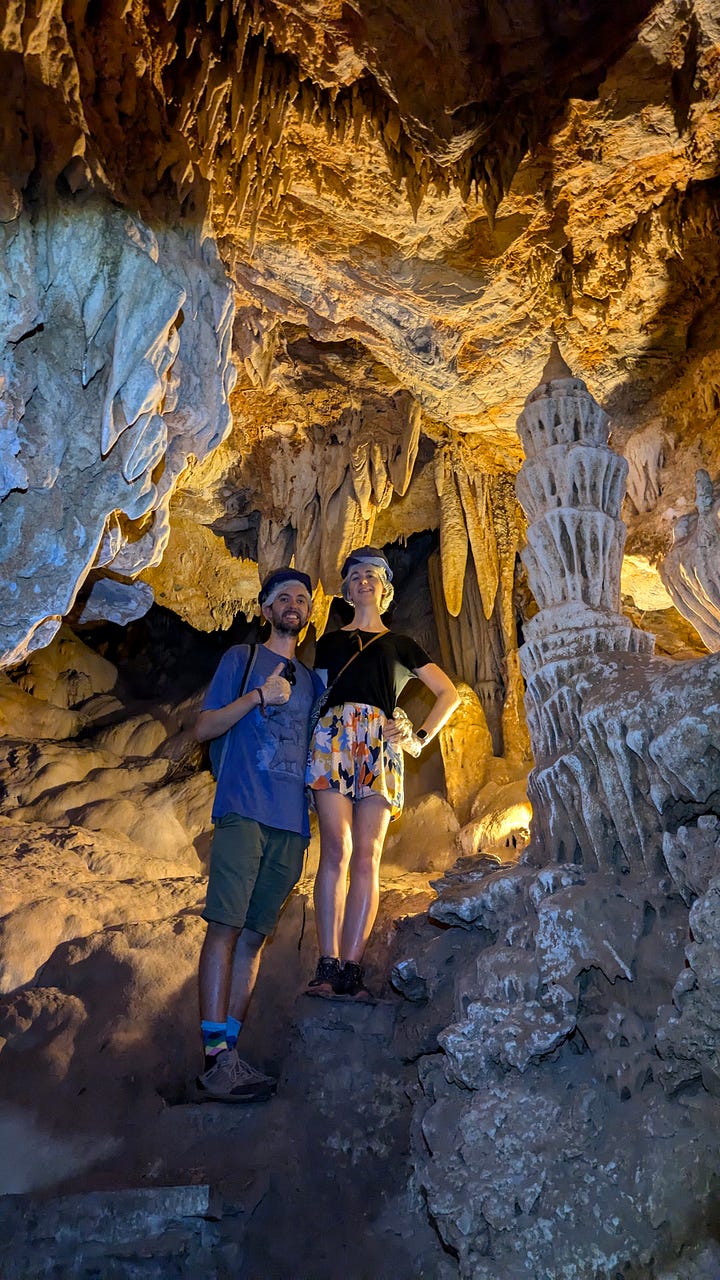
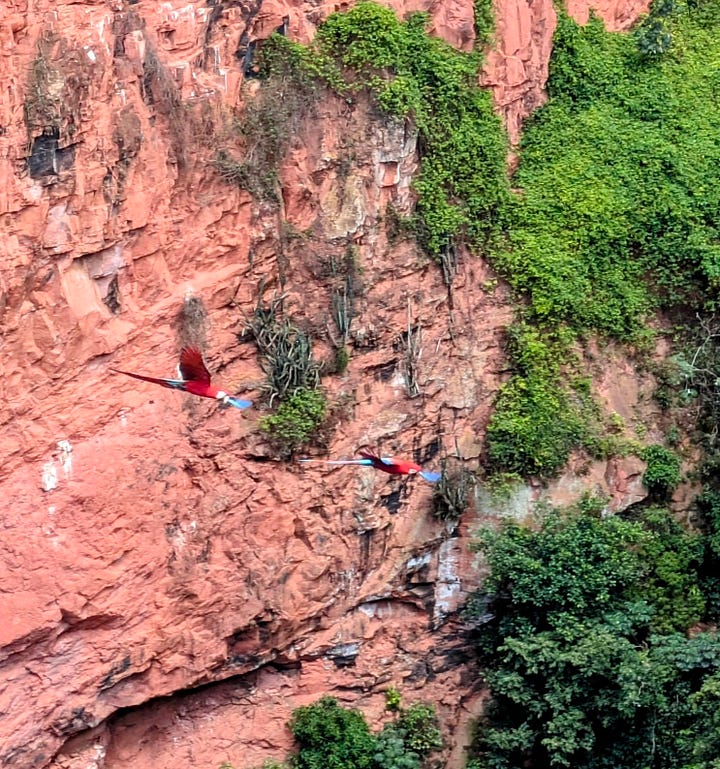
The main event of the day was “flotation”, as the Brazilians call it – snorkelling with the current to you and me. The Rio da Prata has natural springs filtering through the rocks that make the water so clear you really feel as in you are in an aquarium. For two blissful hours, we allowed ourselves to be led gently by the current downstream, face down among 70 species of colourful fish in the glistening sunshine. The experience was so ethereal and surreal it felt like a VR simulation designed as some kind of wellness therapy. I emerged with a blissful feeling, like a combination of the post-scuba diving high and that of a deep tissue massage.
The following day we feared rain, so I somehow agreed to visit another horrible cave, this time the Gruta Cathedral, so named because one of the many weird and wonderful natural rock formations inside it is shaped like a cathedral. Or maybe more like the leaning tower of Pisa. At any rate, this cave was much bigger than other horrible caves I’ve been made to go in this year, and with legitimate tourism safety tools such as hard hats and lighting (ie, not just a hole in the ground in some bloke’s back garden). What can I say? It was a cave. It was quite cool, I guess, if you like damp and darkness and the constant threat of burial and suffocation.
As a reward, we spent the afternoon visiting the cutest animal rescue farm to see a family of tapirs who had adopted the world’s fattest capybara; a trio of disabled monkeys; a desperately trying peacock, and two pumas unable to return to the wild because of behavioural problems (they’d either come from a zoo or been traumatised in some other way by humans and were unable to hunt for themselves. But now they have a very nice life). All very gentle and lovely family-friendly fun, and crucially, all very low budget compared to the previous day.
After a failing to do so in Bolivia and Paraguay, Brazil’s much more transparent tourism offerings meant Dave and I were finally going to see the Pantanal, from the Brazilian side. We chose a tour in the Southern Pantanal, which is easier to get to and about a third of the price of visiting the northern Pantanal, but with the trade-off that you’re less likely to see jaguars. I won’t bury the lede here, we didn’t see any jaguars. But the trip was still so worth it for four days of really solid fun in the wilderness.
Dave and I stayed at the Pantanal Jungle Lodge in Passo do Lontra, which is about a four-hour drive west of Campo Grande on the Miranda river. Activities such as boat tours for wildlife spotting, horse riding and piranha fishing were included in the price of our stay, and organised in a very similar way to the place we stayed at in the Peruvian Amazon near Iquitos, albeit it much less rustic. This place had not only wifi but also air conditioning in our very lovely little room, not to mention a pool, and a flock of European backpackers draped around it at all hours. Gun to my head, I preferred the rustic Amazon version as an overall experience, but I was very glad to jump in that pool several times a day followed by a cold beer from the bar – the heat was seriously intense, especially when sitting in blazing sunshine for hours on our boat trips.
The adventure began before we arrived at the lodge, when the driver, a quiet, often giggling man (I want to say Erik?) who had come to pick us up from town, pulled over on a motorway bridge and beckoned us out the car. We crept down underneath the bridge to see a bunch of caiman, about 20 of them, chilling out in what was left of the river water under the busy bridge. Erik gailey bounded up to them and started gently bothering them with sticks to clear our path.
Because I’m human, I had up until this point been low-level scared of caiman, certainly of getting too close to them and their enormous toothy jaws at any rate. So when Erik started petting one of them with his bare hand I did wonder if we were in the care of a madman. Was this how we died?
Not ones to turn down an opportunity for bravery and kudos, both Dave and I came around to the idea of stroking the caiman’s tails, too. (Our fellow passengers, a friendly Dutch couple, declined.) The caiman didn’t seem angry about it, more resigned to the fact their post-lunchtime nap was being disturbed by the madman who probably came to poke them around like this a couple of times a week. I don’t know if I was expecting them to feel soft like a leather handbag or what, but their skin felt prehistorically rigid – much more like tree bark than reptile.
We also learned (from the man who was mildly bullying the caiman) that these creatures are pretty much the little bitches of the jungle ecosystem – every other large being will bully or eat them, including jaguars and anacondas. Even giant river otters will launch a group attack on a caiman to kill and eat it. These poor toothy guys are actually the victims! So misunderstood. I still have a healthy respect for them and their big jaws, though.

Once at the lodge, our guide for the four-day stay was Rodrigo, a likeable man with a bit of a train wreck energy, whom I quickly suspected wasn’t hugely confident in his own capabilities out on the water. Unlike in the Amazon, where we had a very curated private tour with our own guide and boat driver for the duration (unexpected and mad given the low price), the activities at the Pantanal Jungle Lodge were organised in bigger groups, but at least this had the benefit of more pairs of eyes watching for wildlife.
Rodrigo’s approach to wildlife spotting involved driving the boat at it at full speed until the poor animals scattered and we passengers were left in a cloud of riverbank plants and mosquitoes (and holy hell, the mosquitoes…). On multiple occasions, Rodrigo asked the group if anyone was familiar with driving a boat – I suspect because he wasn’t, especially – and eventually he did crash us quite spectacularly into the riverbank after the engine cut out.
As our boat was pulled downstream by the current, we scraped along through trees and bushes, dodging branches while Rodrigo repeated helplessly, “Not my fault, everyone’s ok, not my fault,” and beginning to hope that we didn’t come to face-to-face with any carnivores, especially given Rodrigo apparently had no phone signal or way of contacting the lodge for help.
Luckily, a very genetically blessed Swiss man who looked like he might own multiple boats stepped up to the challenge and helped to get the engine started again and we lived to fight another day. I believe that there are jaguars living near the Pantanal Jungle Lodge, because Rodrigo pointed out a neighbouring house whose family dogs keep getting eaten (and yet they kept getting more dogs?!) but I suspect any jaguars who might have been lurking that day nearby were probably scared well away by the commotion.
Our group took a couple of trips up and down the river, eyes peeled for jaguars of course, but we did see lots of caiman, howler monkeys, colourful birds like toucans, and plenty of swimming capybaras, who I think are my favourites. I just love their mud partying, grass guzzling, giant guinea pig vibes.
One afternoon we had a magical time kayaking, just five of us in absolute stillness and quiet, watching toucans and giant river otters (though those guys are not quiet at all – have you ever heard the sound an otter makes? It’s ridiculous). Another sweltering afternoon, we got in the river with the capybaras – once again one of those things you just do as a visiting tourist when your guide tells you to – even having just seen a bunch of caiman and piranhas a few metres downstream.
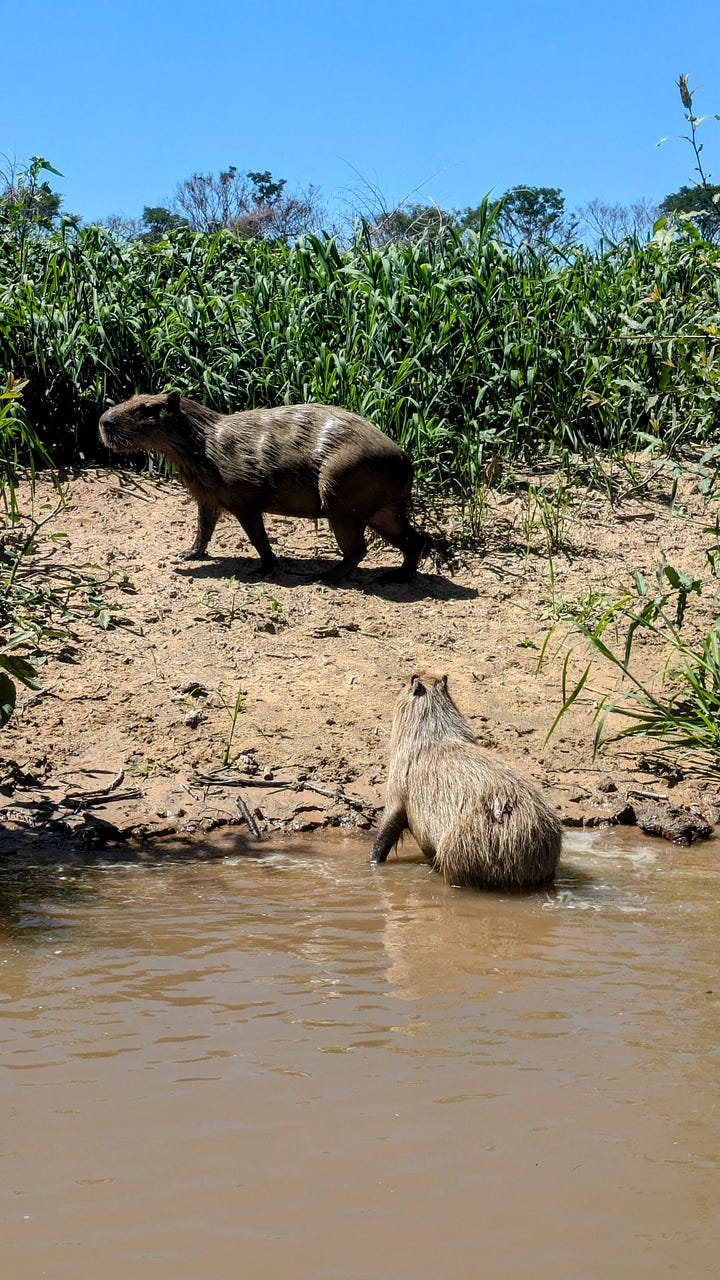
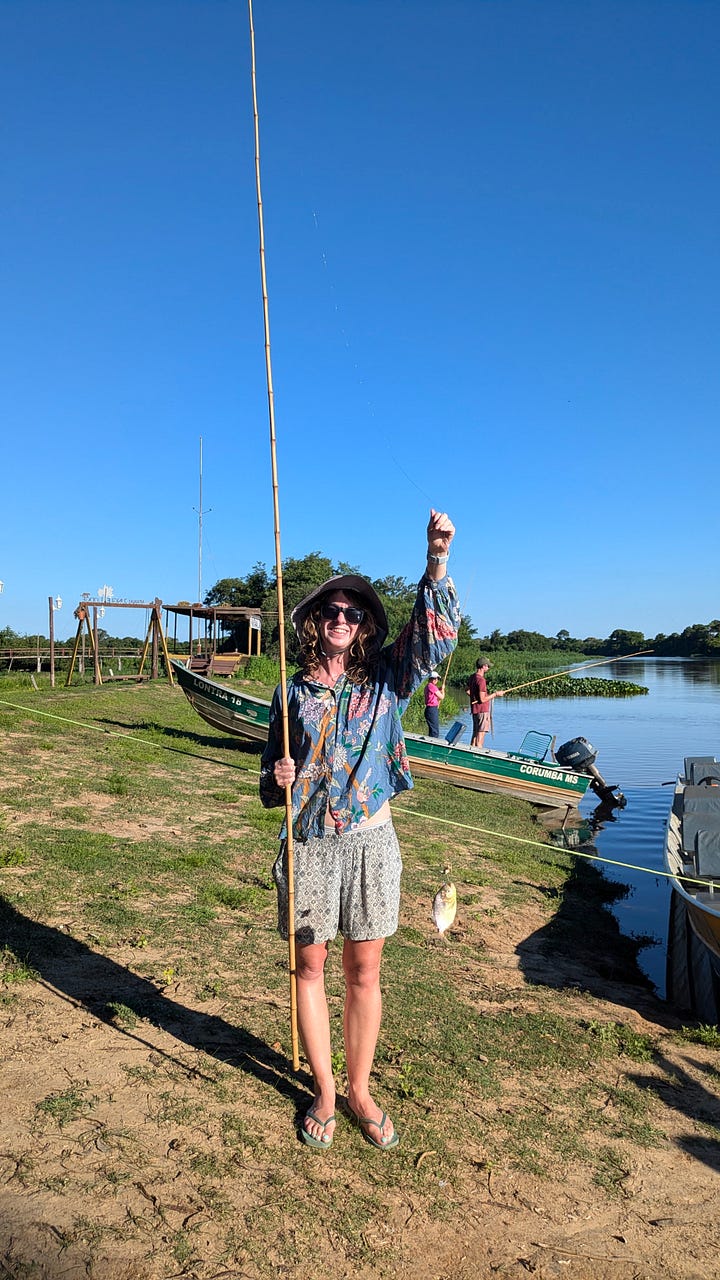
And speaking of piranhas, Dave and I had another turn at fishing them, this time from the shore on longer and more robust bamboo rods. Piece of cake. I caught two big ones within ten minutes and decided that would do me and headed off to seek a cold drink and some shade. Dave, scarred by his failed attempts to catch one in the Amazon, stood stoically, line in hand, for the next two hours. One by one, our fellow fisher people gave up for the evening; the sun began to dip into the water and the mosquitos were already feasting, our guide was long gone. Eventually, I gently suggested it might be time for a beer and poor Dave agreed to step away from the fight. Piranhas 2: Dave 0.
From the Pantanal, Dave and I trekked back to Campo Grande, enjoying relative luxury* (emphasis on the word relative) at the Ibis Budget hotel for Dave’s birthday and plenty of beers, cocktails and an afternoon spent observing some of the fish we’d shared a river with close up from the safety of the city’s very impressive aquarium. And then the following day it was time to hit the road once again and settle in for another long bus journey north.
Travel bits and tips from this week
From the Mbaracayu Lodge in Paraguay, Dave and I took buses eastwards to Ciudad del Este on the border. We stayed in this sad little Airbnb and ate at Bellini (a Subway-style fast food pasta restaurant based in malls) Halals Restaurante Arabe (no alcohol served, but great food).
From the border, we took a ten-hour bus to Londrina, details of which you can hear all about in the previous newsletter.
It was another 11-hour bus from Londrina to Campo Grande in the state of Mato Grosso do Sul – this was a good jumping off point for both the Pantanal and Bonito.
We stayed at the Cerrado Hotel which was very pleasant, though we did completely flood our room and have to move down the corridor due to a misunderstanding over the shower drain.
We had excellent sushi at Temakeria.
In Bonito (five hours from Campo Grande), we stayed at Pousada Tabajós: an absolute steal at less than £13 per night and it came with a banging breakfast.
Bonito is a strange beast: you have to book every tour through an agency and get a “voucher”, but it doesn’t matter which agency you buy from since they all offer the same tour at the same price, as dictated by the local government. We went with Passeios&Co because they had a shiny office with good air conditioning and were responsive on Whatsapp. We booked the all-day Rio da Prata tour to see macaws and go freshwater snorkelling.
The following day we walked from town to get to the Gruta Cathedral, which took about 40 minutes – absolutely fine if you can hack the heat, but this being Brazil there are very few pavements, so it did require a mild bit of traffic dodging on the main road.
Our tour guide only spoke Portuguese, but luckily for us we were joined by a very friendly English-speaking man from Portugal, who could translate some of the main info.
The Gruta Cathedral also has a mad museum attached to it with no apparent theme – lots of badly taxidermied animals and old bits of machinery, which is fine.
Later that day we visited the Biopark, a very lovely rescue and rehabilitation centre for disabled and mistreated animals, including monkeys, pecories, deer, snakes, parrots, maned wolves and a very funny family of goats.
Dining in Bonito is on the pricier end, but we had a great lunchtime buffet at Restaurante do Marco Velho, and twice we went to Subway. No regrets.
In the evenings we mostly ate at the Vila Rebuá Gastronomia food court (sushi for me, pizza for Dave) which was casual and had a nice vibe. Great fun was also had at Bonito Beer, where you can top up a rechargeable card and serve yourself pints from the taps.
Next, we stayed at the Pantanal Jungle Lodge in Passo do Lontra. We booked it through and it was decent value – they sent a driver to pick us up from our hotel, before taking our payment in cash in a supermarket car park.
Back in Campo Grande, we stayed at the Ibis Budget hotel in honour of Dave’s birthday. We visited the Bio Parque Pantanal aquarium (excellent, very shiny and free!) and ate at Território do Vinho (fancy, good food and wine, rather strange staff).

